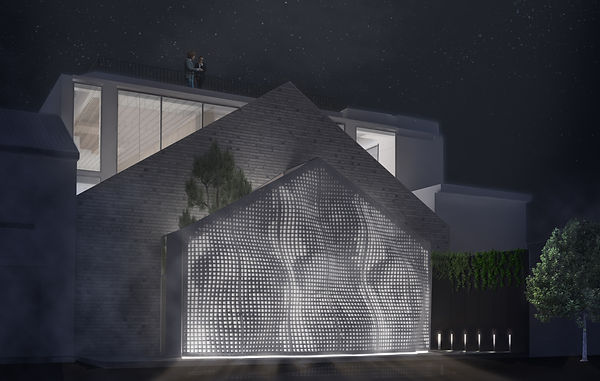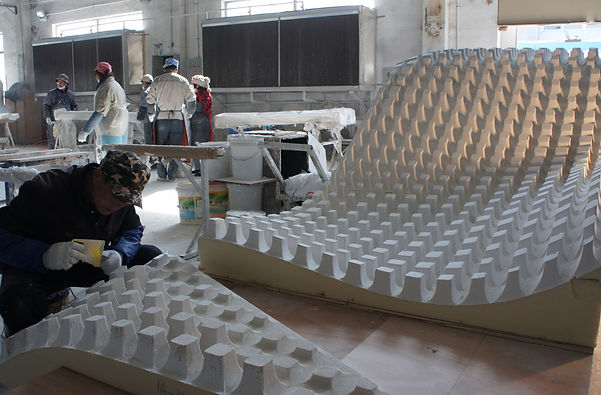Mo Zheng & Martin Miller Design
"THE MAOHAUS" 16 BanQiao Hutong Facade | 板桥16号胡同立面项目
Beijing, China 中国,北京




MAOHAUS PHOTPGRAPHY

MaoHaus is an experimental façade piece exploring historical context, material potentials, novel fabrication and performative qualities within architecture. Taking the simple frame and edge condition of the existing structure, the façade enters the space of the hutong as a flowing fabric. This fluidity is expressed through the conventionally rigid material of concrete questioning inherent perceptions of materiality through formal expression. Beyond the undulating form, the perforations of the surface serve to filter light, during the day, rays of sunlight enter the vestibule, and at night the precisely tuned apertures reveal a triptych of Chairman Mao’s prototypical portrait. The expression of Chairman Mao within the façade is a nod to the historical context of the site. The work is located in a Hutong alley in central Beijing adjacent to The People’s Art House Print Shop, this workshop was once one of the primary producers of the Chairman’s now iconic image.
The structure of the façade leverages the material properties of ultra-high performance concrete to create novel architectural form. Ranging from 4 to 7 meters in height, 2 meters wide and a mere 7 centimeters thick, the 6 individual panels span the façade without the need for any substructure or support. Each panel is cast as a single unit from large CNC milled molds. Computationally generated through fluid-dynamics algorithms, the curvature of the thin porous surface serves to more efficiently carry the loads of the structure to the foundation.
The array of apertures across the surface play several roles within the design, removal of weight for structural integrity, expression of imagery and historical context and also as a means of interacting with the user within the tight space of the hutong alley. In unison with the curvilinear surface, the apertures align themselves to a particular region in the space. Visitors to the site will experience and interact with the façade very differently depending on their relative position as well as time of visit. From certain vantages, the façade is perceptibly flattened revealing the embedded image, while from other points it may read as flowing banner frozen in time.
MaoHaus seeks to explore various elements of deign within a singular expression. Looking to new material innovation the façade pushes the limits of what may be achieved from seemingly conventional architectural materials. Seeking a multifaceted design, MaoHaus exists as a synthesis of material properties, customized computational tooling and generation with historical reference, context and expression.
Architects: AntiStatics Architecture
Project Type: Digital Fabricated Façade
Project Location: Beijing, BanQiaoNanXiang
Principal Architect: Martin Miller, Mo Zheng
Design Team: Luke Theodorius E. D. Santoso, Zhiwen Sun, Frank Lee
Fabrication and Installation: eGRow
Facade Area: 70sqm
Building Area: 2000sqm
Complete Date: 2017/06
Photographer: Xia Zhi
项目地址:北京,板桥南巷
项目类型:外墙设计、建造
外墙面积:70平方米
建筑面积;2000平方米
时间:2017年5月 (建成)
设计总监:马丁·米勒(美)、郑默
设计团队:卢克(印尼)、孙之雯(加)Frank Li
制作:E-Grow
摄影师:夏至































